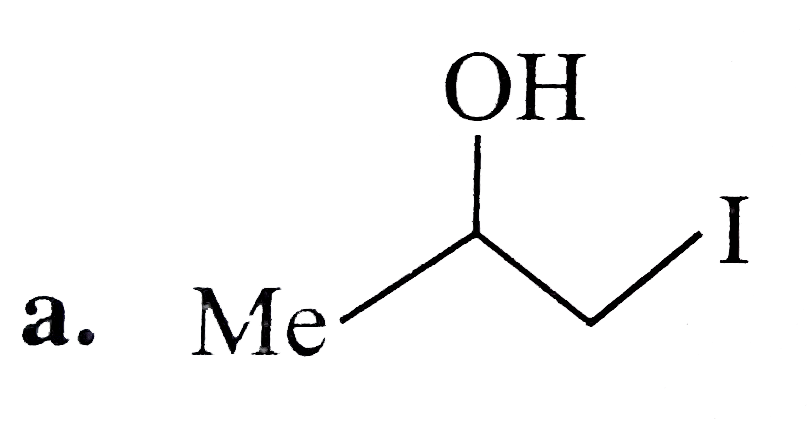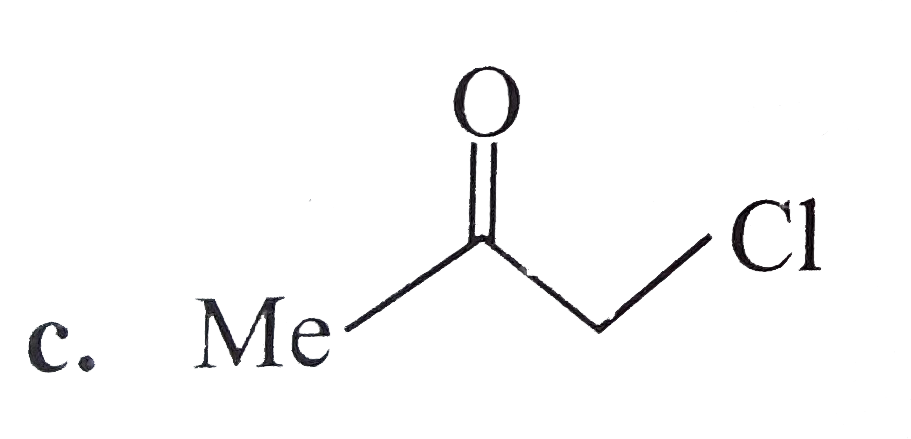Which of the following gives yellow precipitate with NaOI?
a.
b.
c.
d.All
The correct Answer is:D
To determine which of the given compounds gives a yellow precipitate with NaOI (sodium iodide), we need to identify compounds that can undergo the iodoform reaction. The iodoform reaction is characterized by the formation of a yellow precipitate of iodoform (CHI3) when a compound containing a methyl ketone group (RCOCH3) or a secondary alcohol with a methyl group adjacent to the hydroxyl group is treated with iodine in the presence of a base.
1. Understand the Reagent:
- The reagent NaOI is derived from NaOH and I2, and it is known as the haloform reagent. It is used to identify compounds that can form iodoform.
2. Identify the Functional Groups:
- For a compound to give a positive iodoform test, it must contain either:
- A methyl ketone group (RCOCH3), or
- A secondary alcohol that can be oxidized to a methyl ketone.
3. Analyze Each Option:
- Without the specific options provided, we will assume there are several organic compounds given. We need to check each compound for the presence of the required functional groups.
- For example:
- Compound A: CH3COCH3 (methyl ketone) - Yes, gives yellow precipitate.
- Compound B: CH3CH(OH)CH3 (secondary alcohol) - Yes, gives yellow precipitate.
- Compound C: CH3(CH2)2OH (primary alcohol) - No, does not give yellow precipitate.
- Compound D: CH3C(O)CH2OH (secondary alcohol) - Yes, gives yellow precipitate.
4. Conclusion:
- After analyzing the compounds, the ones that contain either the methyl ketone or the secondary alcohol structure will give a yellow precipitate with NaOI.
- If all options A, B, and D fit the criteria, then they will all give a yellow precipitate.
5. Final Answer:
- The correct answer is that all compounds that contain the specified functional groups will give a yellow precipitate with NaOI.
- The reagent NaOI is derived from NaOH and I2, and it is known as the haloform reagent. It is used to identify compounds that can form iodoform.
- For a compound to give a positive iodoform test, it must contain either:
- A methyl ketone group (RCOCH3), or
- A secondary alcohol that can be oxidized to a methyl ketone.
- Without the specific options provided, we will assume there are several organic compounds given. We need to check each compound for the presence of the required functional groups.
- For example:
- Compound A: CH3COCH3 (methyl ketone) - Yes, gives yellow precipitate.
- Compound B: CH3CH(OH)CH3 (secondary alcohol) - Yes, gives yellow precipitate.
- Compound C: CH3(CH2)2OH (primary alcohol) - No, does not give yellow precipitate.
- Compound D: CH3C(O)CH2OH (secondary alcohol) - Yes, gives yellow precipitate.
- After analyzing the compounds, the ones that contain either the methyl ketone or the secondary alcohol structure will give a yellow precipitate with NaOI.
- If all options A, B, and D fit the criteria, then they will all give a yellow precipitate.
- The correct answer is that all compounds that contain the specified functional groups will give a yellow precipitate with NaOI.
Topper's Solved these Questions
- REDUCTION AND OXIDATION REACTION OF ORGANIC COMPOUNDSBOOK - CENGAGE CHEMISTRY ENGLISHCHAPTER - REDUCTION AND OXIDATION REACTION OF ORGANIC COMPOUNDSEXERCISE - Exercise (Assertion And Reasoning)
10 Videos
- REDUCTION AND OXIDATION REACTION OF ORGANIC COMPOUNDSBOOK - CENGAGE CHEMISTRY ENGLISHCHAPTER - REDUCTION AND OXIDATION REACTION OF ORGANIC COMPOUNDSEXERCISE - Exercise Archives (Subjective)
26 Videos
- REDUCTION AND OXIDATION REACTION OF ORGANIC COMPOUNDSBOOK - CENGAGE CHEMISTRY ENGLISHCHAPTER - REDUCTION AND OXIDATION REACTION OF ORGANIC COMPOUNDSEXERCISE - Exercise (Multiple Correct)
35 Videos
- QUALITATIVE INORGANIC SALT ANALYSISBOOK - CENGAGE CHEMISTRY ENGLISHCHAPTER - QUALITATIVE INORGANIC SALT ANALYSISEXERCISE - Viva Voce Questions And Part-C (Analysis Of Cations)
42 Videos
- SOLID STATEBOOK - CENGAGE CHEMISTRY ENGLISHCHAPTER - SOLID STATEEXERCISE - Ex 1.2 (Objective)
9 Videos
Similar Questions
Knowledge Check
Which of the following will not give white precipitate with
ammoniacal silver nitrate solution ?ACH3−C≡C−CH3B C
C D
D
Which of the following gives a precipitate with Pb(NO3)2?
View SolutionWhich of the following gives a precipitate with Pb(NO3)2 but not with Ba(NO3)2 ?
View SolutionWhich of the following solution gives precipitate with Pb(NO3)2 but not with Ba(NO3)2
View SolutionWhich of the following does not give a precipitate with alcoholic AgNO3 ?
View SolutionWhich of the following reagents gives white precipitate with Hg(NO3)2 solution?
View SolutionAqueous solution of which of the following cation gives precipitate with potash alum?
View SolutionAqueous solution of which of the following cation gives precipitate with potash alum?
View Solution
